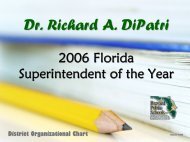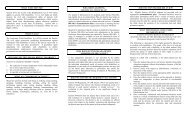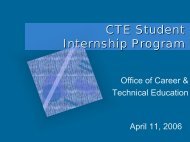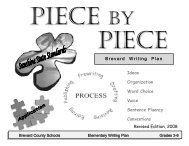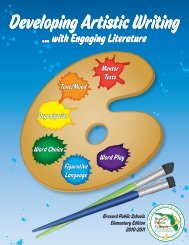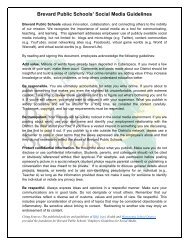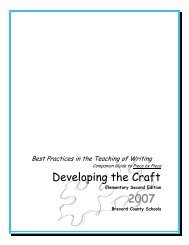2007-08 K-12 Comprehensive Research-Based Reading Plan
2007-08 K-12 Comprehensive Research-Based Reading Plan
2007-08 K-12 Comprehensive Research-Based Reading Plan
Create successful ePaper yourself
Turn your PDF publications into a flip-book with our unique Google optimized e-Paper software.
Moving forward, the Comprehension Instructional Sequence (CIS) will be thecornerstone of our support for content area teachers – it is critical to the success ofour students. In fact, the English Language Arts curriculum guides are beingrewritten this summer and the CIS will be embedded as an example of best practice.Additionally, all English Language Arts and reading teachers will be receivingtraining in the Common Core State Standards over the next two years:Session 1: Overview, Developing a K-U-D: Where Standards and DI MeetSession 2: ELA – Unpack the Language Cluster; <strong>Reading</strong> – Unpack theFoundational Skills ClusterSession 3: Unpack the <strong>Reading</strong> Informational and <strong>Reading</strong> Literature ClustersSession 4: Vendor Showcase for Adoption – Review for alignment to CCSSSession 5: Unpack the Speaking and Listening Cluster; Socratic Seminar,Philosophical Chairs, Discussion ProtocolsSession 6: Literacy Design Collaborative and/or Tiered Lesson (DI)In addition to the modules being required through Professional Development Day,teachers will required to participate in training on the following six topics:1. Understanding the Staircase of Complexity2. Utilizing the Comprehension Instructional Sequence3. Innovative Grammar4. Teaching how to Write from Sources5. Close <strong>Reading</strong> and Text Dependent Questioning6. Best Practices for Increasing Rigor in the ELA ClassroomContinued training for social studies teachers will strengthen and increase the useof Document <strong>Based</strong> Questions (DBQs). DBQs require students to participate in notonly close reading but in answering text-based questions. Thinking Maps are oftenutilized as a way for students to organize information in social studies content aswell. This aid in organizing information allows students the ability to more deeplycomprehend the text as demonstrated by written responses and discussions.Teachers will receive training in Socratic Seminars and Philosophical Chairsactivities that require students to cite specific information from the text to supporttheir answer. Word walls and vocabulary instruction focused on pertinentGreek/Latin roots, suffixes and prefixes aid in student comprehension of disciplinespecific words.The Middle School Science Curriculum Guide is being updated to provide templatesand resources for science teachers to use as they develop differentiated instructionlessons that will provide opportunities to expand literacy development in theirstudents. A curriculum writing team of middle school science teachers will use thecurrent 8 th grade Content Literacy Standards Aligned with the Anchor Standards –Writing and <strong>Reading</strong> as a framework to develop content specific activities andresources to facilitate literacy. There will be training offered to middle schoolscience teachers during the summer and fall for this framework and its appropriateuse in lesson development. Literacy development will include science vocabulary,critical analysis of informational texts, and the scientific process. The scientificprocess includes a student-generated question being researched and tested to arrive29 | P a g e






